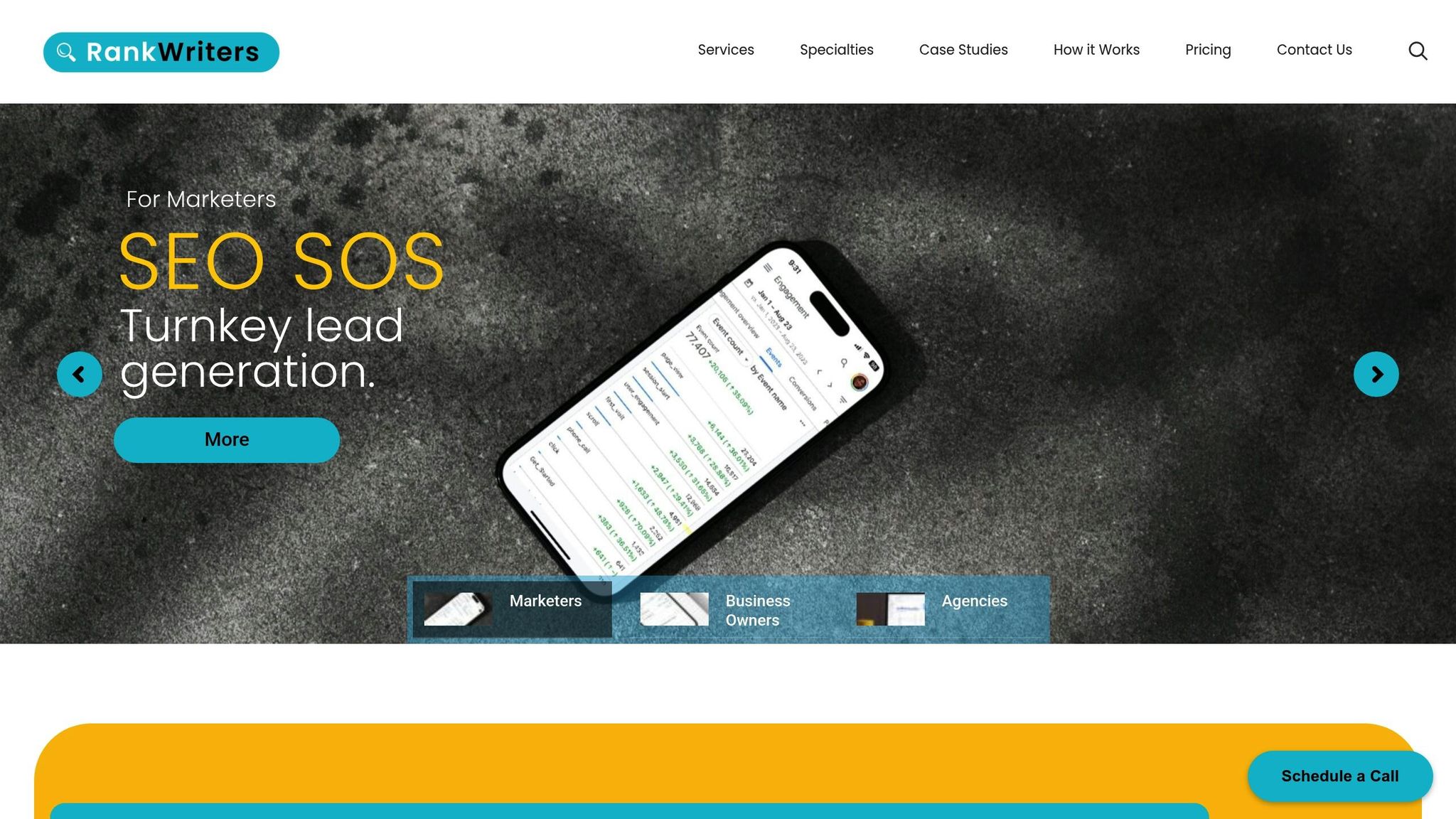Here’s how to prioritize keywords to boost your law firm’s online visibility:
- Focus on Search Intent: Choose keywords that match what potential clients are searching for, like “Dallas divorce lawyer” or “how to file for bankruptcy.”
- Balance Search Volume and Competition: Aim for keywords with decent monthly searches but lower competition to rank faster.
- Organize by Practice Area and Location: Group keywords by legal services you offer and your geographic area.
- Use a Scoring System: Rank keywords by factors like relevance, competition, and ROI to target the best opportunities.
- Avoid Common Mistakes: Skip overly broad terms like “personal injury lawyer” and focus on long-tail keywords that attract ready-to-hire clients.
Quick Tip: High-value, low-competition keywords are your best bet for driving targeted traffic and generating leads.
Want to learn more about creating a keyword strategy that works? Read on for a detailed guide.
Law Firm SEO: Keyword Strategy to Rank #1 in 2025!
Starting Your Keyword Research
Keyword research is the backbone of law firm SEO. It helps you identify, assess, and organize terms that can attract the right audience to your website.
Finding Relevant Keywords
Start by matching your primary practice areas with keywords that showcase your expertise. Here are some categories to consider:
- Practice Area Terms: Focus on the legal services you offer, like personal injury lawyer or estate planning attorney.
- Location-Based Keywords: Combine your practice areas with geographic terms, such as Dallas divorce lawyer or Houston criminal defense attorney.
- Client Pain Points: Target common legal concerns your clients face, like how to file for bankruptcy or what to do after a car accident.
Measuring Search Data
When evaluating keywords, pay attention to these key metrics:
- Search Volume: The number of monthly searches a keyword receives, indicating its potential reach.
- Competition Level: How difficult it is to rank for the keyword.
- Search Intent: The user’s purpose behind the search, whether it’s informational or commercial.
- Relevance: How closely the keyword aligns with your legal services.
Aim for keywords with a balance of decent search volume and lower competition. Mid-level search volume keywords often lead to better results without excessive effort.
Organizing Legal Keywords
Organize your keywords into categories that align with your services and target audience. This creates a logical structure for your content. Here’s how you can group them:
- Primary Practice Area: Include terms related to your core services, related legal phrases, and common client questions.
- Geographic Focus: Use combinations of city, state, and regional terms, as well as references to local courts or jurisdictions.
- Client Journey Stage: Cover keywords for different stages, such as research phrases, consultation triggers, and hiring intent terms.
With this structure in place, you’ll be ready to build a prioritization framework to guide your SEO strategy.
Creating Your Priority Framework
Now that your keyword lists are organized, it’s time to rank them using a structured approach.
Choosing Priority Factors
When prioritizing keywords, focus on these key elements:
- Search Intent Match: Does the keyword align with your practice areas and what your clients are searching for?
- Competition Level: How difficult will it be to rank for this keyword?
- Business Value: What is the potential return on investment (ROI) if you rank for this keyword?
- Content Resources: Can you create strong, relevant content for this topic?
- Geographic Relevance: Is local search important for this keyword and your practice?
Assign weights to these factors based on what matters most to your firm. For instance, if certain practice areas bring in higher-value cases, you might weigh business value more heavily. Then, score each keyword based on these factors.
Creating a Scoring System
Set up a scoring system to evaluate keywords effectively. Here’s a sample framework:
| Factor | Score Range | Weight | Criteria |
|---|---|---|---|
| Search Intent | 1-5 | 30% | 5: Direct client intent 3: Research phase 1: Unrelated intent |
| Competition | 1-5 | 25% | 5: Low competition 3: Moderate 1: Highly competitive |
| Business Value | 1-5 | 25% | 5: High-value cases 3: Average value 1: Low value |
| Content Feasibility | 1-5 | 20% | 5: Easy to create 3: Moderate effort 1: Resource intensive |
For each keyword, multiply the score by its weight and sum the results for a total score (1–5). Once you have these scores, use them to organize your keywords visually.
Visualizing with Priority Charts
Use priority charts to organize your keywords and guide your strategy. Set up a matrix with four quadrants:
- High Priority: Keywords with high business value and low competition.
- Quick Wins: Lower-value keywords that are easy to rank for.
- Long-term Goals: High-value keywords that are more competitive.
- Low Priority: Keywords with low value and high effort.
Update these charts every quarter to stay aligned with search trends and your firm’s resources.
Putting Keywords to Work
Matching Keywords to Pages
Assign your most important keywords to specific legal pages to strengthen your authority on those topics. Build content pillars by focusing on each practice area and aligning your keyword strategy with different search intents. For high-priority keywords that show commercial intent, create dedicated landing pages. Support these with blog posts and resources aimed at answering informational queries. Once you’ve mapped keywords to the right pages, optimize those pages with essential SEO elements.
SEO Page Elements
Make sure your page titles, meta descriptions, headers, URLs, and content are optimized with your target keywords:
- Title: Include the main keyword prominently.
- Meta Description: Use target keywords to improve click-through rates.
- Headers: Place the primary keyword in the main heading and related terms in subheadings.
- URL Structure: Keep it clear and keyword-focused.
- Content Body: Integrate keywords naturally into the text.
After optimizing these on-page elements, keep an eye on performance by tracking specific metrics.
Measuring Results
Use your prioritization framework to evaluate how well your strategy is working. Here’s what to track:
| KPI | What to Monitor |
|---|---|
| Keyword Rankings | Changes in positions for target keywords |
| Organic Traffic | Number of visitors from search engines |
| Conversion Rate | Actions like inquiries, calls, or form fills |
| Click-Through Rate | How often users click on your search results |
Regularly review these metrics and adjust your keyword strategy as needed.
Common Keyword Mistakes
Fine-tune your keyword strategy by steering clear of these frequent missteps.
High-Volume Keyword Trap
Keywords like "personal injury lawyer" or "divorce attorney" may seem appealing due to their high search volume. However, these terms are extremely competitive and often attract less qualified leads. Instead, prioritize keywords that show clear intent to hire legal services.
For example, phrases like "car accident lawyer consultation" or "filing for divorce in [city]" may have fewer searches but tend to attract users ready to take action. These individuals are more likely to convert into actual clients.
Ignoring Long-Tail Keywords
Long-tail keywords can drive highly targeted traffic. Create content around specific phrases that address particular legal needs:
| Keyword Type | Example | Intent |
|---|---|---|
| Basic Term | "family lawyer" | General research (low conversion) |
| Long-tail | "child custody modification lawyer near me" | Ready to hire (high conversion) |
| Specific Issue | "how to contest a will in California" | Seeking solutions (moderate conversion) |
| Location-based | "estate planning attorney San Francisco" | Local service (high conversion) |
These detailed phrases help you connect with users who are closer to making a decision.
Misunderstanding Search Intent
Content that doesn’t match the user’s search intent can hurt your effectiveness. Tailor your content to fit these primary intent types:
- Informational Intent: Use keywords like "how to", "what is", or "when can I" to educate and build trust.
- Navigational Intent: Target branded or practice-specific searches to guide users directly to your services.
- Commercial Intent: Focus on landing pages optimized for conversion when targeting high-intent keywords.
For instance, someone searching "wrongful termination lawyer fees" is likely ready to hire. Address their concerns by providing clear details about costs and payment options. Avoid offering general legal information that doesn’t answer their specific query.
Next Steps
With your keyword framework in place and common mistakes avoided, it’s time to take action and achieve measurable results.
Quick Guide Review
Use these steps to turn your keyword research into real outcomes. Start by diving into focused legal keyword research. Organize your findings into tiers based on factors like search intent, competition, and conversion potential. This approach helps you target prospects who are ready to take action.
Success Guidelines
Keep track of your keyword performance by focusing on these key metrics:
| Metric Type | What to Monitor | Target Goal |
|---|---|---|
| Keyword Growth | Search Rankings | Top 3 positions |
| Lead Generation | Form Submissions | Monthly increase in qualified leads |
| Client Contact | Phone Calls | Track call volume from organic search |
| Content Performance | Page Views | Engagement with priority keywords |
Revisit and update your keyword research every six months to stay relevant and spot new opportunities. Develop content pillars that focus on specific legal practice areas, making it easier for search engines to recognize your expertise and authority.
Need help implementing this framework? Our team is here to help you get the most out of your efforts.
RankWriters Services

Transform your blog into a powerful lead generator with RankWriters’ content marketing subscription. We provide targeted keyword research, strategic content planning, and monthly performance tracking to ensure your law firm connects with the right audience.
Starting at $1,450 per month, our service includes expertly written blog posts optimized for search engines and designed to convert high-intent visitors into qualified leads. Our content pillar strategy organizes your website content effectively, creating clear paths for potential clients to find and engage with your services.
Track your success with detailed monthly reports that cover keyword growth, phone calls, and form submissions – key metrics that drive marketing success for law firms.







